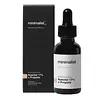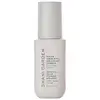What's inside
What's inside
 Key Ingredients
Key Ingredients

 Benefits
Benefits

 Concerns
Concerns

No concerns
 Ingredients Side-by-side
Ingredients Side-by-side

Water
Skin ConditioningPotassium Azeloyl Diglycinate
Skin ConditioningPropanediol
SolventGlycerin
HumectantPropolis Extract
Skin ConditioningPseudoalteromonas Ferment Extract
HumectantXylitylglucoside
HumectantAnhydroxylitol
HumectantXylitol
HumectantDimethyl Isosorbide
SolventDipotassium Glycyrrhizate
HumectantGallic Acid
AntioxidantSodium Hyaluronate
HumectantHydroxyethylcellulose
Emulsion StabilisingXanthan Gum
EmulsifyingLecithin
EmollientPhenoxyethanol
PreservativeEthylhexylglycerin
Skin ConditioningSclerotium Gum
Emulsion StabilisingPullulan
Trisodium Ethylenediamine Disuccinate
Lactic Acid
BufferingWater, Potassium Azeloyl Diglycinate, Propanediol, Glycerin, Propolis Extract, Pseudoalteromonas Ferment Extract, Xylitylglucoside, Anhydroxylitol, Xylitol, Dimethyl Isosorbide, Dipotassium Glycyrrhizate, Gallic Acid, Sodium Hyaluronate, Hydroxyethylcellulose, Xanthan Gum, Lecithin, Phenoxyethanol, Ethylhexylglycerin, Sclerotium Gum, Pullulan, Trisodium Ethylenediamine Disuccinate, Lactic Acid
Water
Skin ConditioningDicaprylyl Carbonate
EmollientPotassium Azeloyl Diglycinate
Skin ConditioningMaltodextrin
Absorbent1,2-Hexanediol
Skin ConditioningPropanediol
SolventAvena Sativa Kernel Extract
AbrasiveAloe Barbadensis Leaf Juice
Skin ConditioningDipotassium Glycyrrhizate
HumectantSodium Hyaluronate
HumectantPanthenol
Skin ConditioningHydroxyacetophenone
AntioxidantLactic Acid
BufferingBenzoic Acid
MaskingCitric Acid
BufferingSodium Lactate
BufferingSodium Gluconate
Skin ConditioningSclerotium Gum
Emulsion StabilisingPolyglyceryl-2 Stearate
EmulsifyingXanthan Gum
EmulsifyingGlyceryl Stearate
EmollientStearyl Alcohol
EmollientWater, Dicaprylyl Carbonate, Potassium Azeloyl Diglycinate, Maltodextrin, 1,2-Hexanediol, Propanediol, Avena Sativa Kernel Extract, Aloe Barbadensis Leaf Juice, Dipotassium Glycyrrhizate, Sodium Hyaluronate, Panthenol, Hydroxyacetophenone, Lactic Acid, Benzoic Acid, Citric Acid, Sodium Lactate, Sodium Gluconate, Sclerotium Gum, Polyglyceryl-2 Stearate, Xanthan Gum, Glyceryl Stearate, Stearyl Alcohol
Ingredients Explained
These ingredients are found in both products.
Ingredients higher up in an ingredient list are typically present in a larger amount.
Dipotassium Glycyrrhizate comes from licorice root.
Extracts of licorice have demonstrated to have antibacterial, anti‐inflammatory, antiviral, antioxidant properties.
One component, glabridin, has extra potent antioxidant and soothing properties. It has also been found to block pigmentation from UVB rays in guinea pigs.
Licorice Root also contains a flavonoid. Flavonoids are a natural substance from in plants. Flavonoids also have antioxidant properties.
Another component, glycyrrhizin, has been found to have anti-inflammatory and antimicrobial benefits. This may make licorice root extract effective at treating acne. However, more research is needed to support this.
Liquiritin is one of the flavone compounds found in licorice. It has been found to help lighten skin by preventing tyrosinase from reacting with tyrosine. When the two react, protein is converted to melanin. Melanin is the substance in your body that gives your features pigmentation.
Licorice root is native to Southern Europe and Asia. It has been used in traditional Chinese medicine to help with respiratory issues.
Learn more about Dipotassium GlycyrrhizateLactic Acid is another well-loved alpha hydroxy acid (AHA). It is gentler than glycolic acid but still highly effective.
Its main role is to exfoliate the surface of the skin by loosening the “glue” that holds dead skin cells together. Shedding those old cells leads to smoother, softer, and more even-toned skin.
Because lactic acid molecules are larger than glycolic acid, they don’t penetrate as deeply. This means they’re less likely to sting or irritate, making it a great choice for beginners or those with sensitive skin.
Like glycolic acid, it can:
Lactic acid also acts as a humectant (like hyaluronic acid). It can draw water into the skin to improve hydration and also plays a role in the skin's natural moisturizing factor (NMF) in the form of sodium lactate.
Studies show it can boost ceramide production to strengthen the skin barrier and even help balance the skin’s microbiome.
To get results, choose products with a pH between 3-4.
Lower strengths (5-12%) focus on surface exfoliation; higher strengths (12% and up) can reach deeper in the dermis (deeper, supportive layer) to improve skin texture and firmness over time.
Though it was originally derived from milk, most modern lactic acid used in skincare is vegan. It is made through non-dairy fermentation to create a bio-identical and stable form suitable for all formulations.
When lactic acid shows up near the end of an ingredient list, it usually means the brand added just a tiny amount to adjust the product’s pH.
Legend has it that Cleopatra used to bathe in sour milk to help reduce wrinkles.
Lactic acid is truly a gentle multitasker: it exfoliates, hydrates, strengthens, and brightens. It's a great ingredient for giving your skin a smooth, glowing, and healthy look without the harshness of stronger acids.
Read more about some other popular AHA's here:
Learn more about Lactic AcidPotassium Azeloyl Diglycinate (PAD) comes from the condensation of azelaic acid mixed with glycine.
This ingredient has similar properties to azelaic acid; it can help reduce sebum production and soothe skin. PAD also inhibits tyrosinase activity to help brighten skin. Tyrosinase is an enzyme that controls melanin production.
A study from 2023 found 5% PAD combined with nicotinamide (a form of niacin) effectively reduced melanin production after 6 weeks.
Several studies from the 2010's also show PAD to be effective in alleviating symptoms of Rosacea.
Though this ingredient is considered a gentle active, higher amounts may result in irritation.
Unlike azelaic acid, this ingredient is water-soluble. This property makes it easier to formulate into skincare products.
Learn more about Potassium Azeloyl DiglycinatePropanediol is an all-star ingredient. It softens, hydrates, and smooths the skin.
It’s often used to:
Propanediol is not likely to cause sensitivity and considered safe to use. It is derived from corn or petroleum with a clear color and no scent.
Learn more about PropanediolSclerotium Gum is a polysaccharide gum made by the fungus, Sclerotium rolfssii. It is similar to xanthan gum.
In cosmetics, Sclerotium Gum is used to thicken the texture and to help stabilize other ingredients.
As an emulsifier, Sclerotium Gum helps prevent ingredients from separating, such as water and oil.
Learn more about Sclerotium GumSodium Hyaluronate is hyaluronic acid's salt form. It is commonly derived from the sodium salt of hyaluronic acid.
Like hyaluronic acid, it is great at holding water and acts as a humectant. This makes it a great skin hydrating ingredient.
Sodium Hyaluronate is naturally occurring in our bodies and is mostly found in eye fluid and joints.
These are some other common types of Hyaluronic Acid:
Learn more about Sodium HyaluronateWater. It's the most common cosmetic ingredient of all. You'll usually see it at the top of ingredient lists, meaning that it makes up the largest part of the product.
So why is it so popular? Water most often acts as a solvent - this means that it helps dissolve other ingredients into the formulation.
You'll also recognize water as that liquid we all need to stay alive. If you see this, drink a glass of water. Stay hydrated!
Learn more about WaterXanthan gum is used as a stabilizer and thickener within cosmetic products. It helps give products a sticky, thick feeling - preventing them from being too runny.
On the technical side of things, xanthan gum is a polysaccharide - a combination consisting of multiple sugar molecules bonded together.
Xanthan gum is a pretty common and great ingredient. It is a natural, non-toxic, non-irritating ingredient that is also commonly used in food products.
Learn more about Xanthan Gum